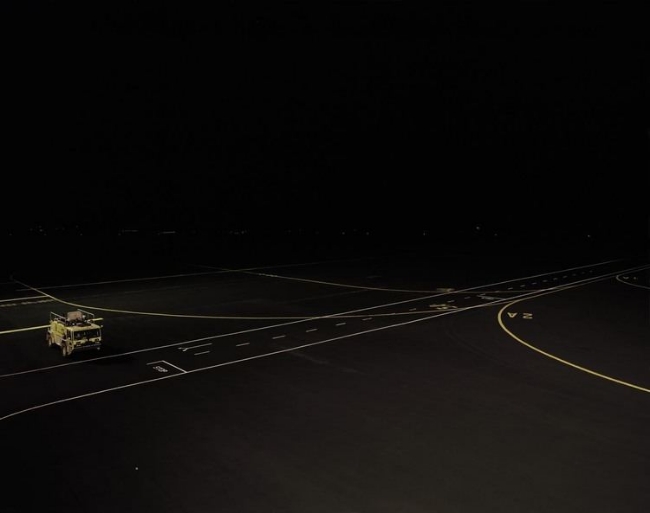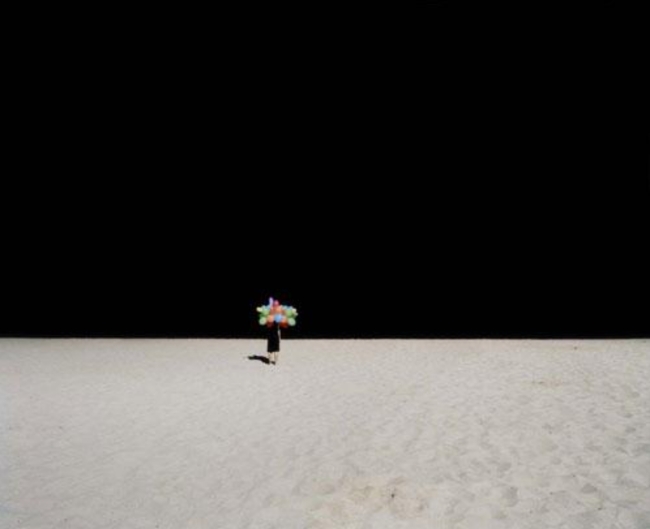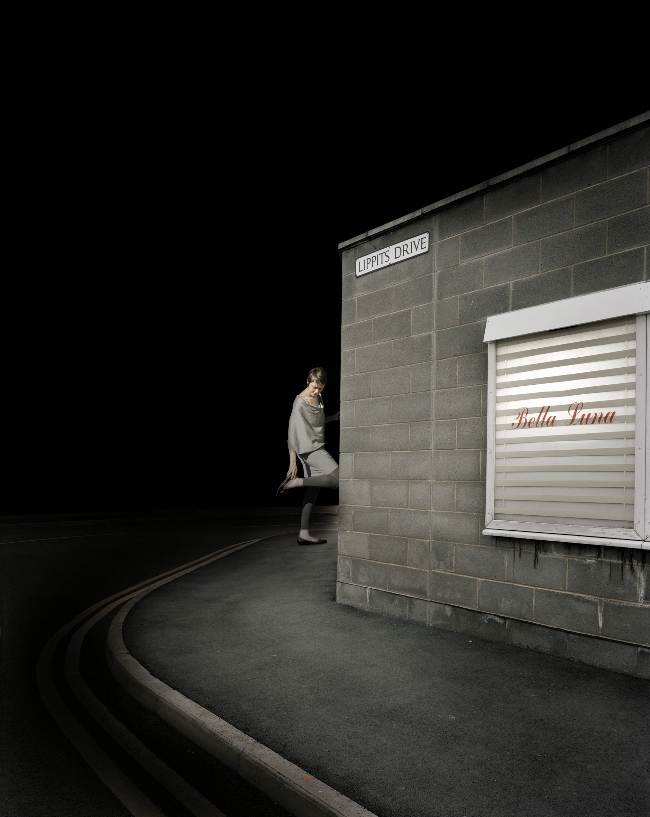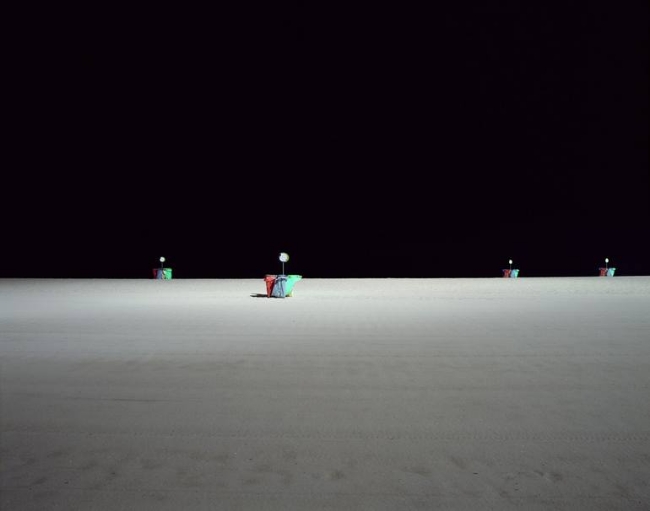Portuguese photographer Edgar Martins takes photographs of anonymous places that hold no particular meaning to the viewer. Airport runways, vacant beaches, highway road barriers—locations and sites with which we’re all familiar, but which are largely barren of any personal connection. He then emphasizes the absence of emotional content by photographing those locations in ways that make them seem even more alien.

Martins’ work is, in many ways, the polar opposite of the images we saw in the last Sunday Salon. The photographs of photographs of Tony Ray-Jones were often hectic, usually densely packed with visual information, and frequently intensely intimate; they were all about documenting the people who inhabit the very distinctive settings. Martins, by contrast, creates photographs that are strangely serene, minimalist, and emotionally distant. His work isn’t the least bit documentary, unless you count the documentation of dreamscapes. The settings are of seemingly unnamed places, either unpopulated or populated by unidentifiable figures engaged in behaviors the viewer doesn’t—and perhaps cannot—understand.
“For a while I thought I would be a writer, and I have also experimented with video and sound. But whatever medium I have used, I have always been interested in communicating ideas about how difficult it is to communicate.”
One of the most consistent features of Martins’ work (or at least the bulk of his work) is the overpowering sense of silence. There is an element of solitude that, despite the occasionally surreal qualities of the image, never feels ironic. Airport runways should be busy and noisy, beaches should be packed with families and holiday-seekers, parking lots and highways should be filled with the raucous bustle of traffic. But these aren’t, and yet somehow the stillness of these scenes feel completely organic.

Edgar Martins was born in Portugal in 1977, but grew up in Macau. He moved to London in 1996. There he earned a BA in Photography and Social Sciences from the University of Arts, and an MA in Photography and Fine Art at the Royal College of Art. Almost immediately on graduation, Martins was receiving photography awards, publishing his work, and getting exhibited internationally. Now, at the age of 32, he’s represented by eight galleries around the world and has published four book of his photographs—the fourth being a retrospective. That’s right, at 32 he already has such an established body of work that Aperture felt it was appropriate to issue a retrospective.
Perhaps it’s the anonymity of his settings that makes his work so universally accessible. Even though most of his images were shot in either Portugal or Iceland, there is no discernible trace of ‘place’ in the work. A runway is a runway, an empty beach at night in Portugal is no different than an empty beach at night in Florida or Australia. And yet as alien as these settings appear, there is also an element of ‘home’ involved, and it’s involved because an empty beach at night in Florida is largely the same as an empty beach at night in Australia. We recognize these scenes as familiar even while we experience them as alien.

It’s that contradictory dichotomy of the known and the unknown, the familiar and the unfamiliar that gives these images such an unsettling quality while still making them captivating. That incongruity isn’t lost on Martins.
“This apparent contradiction, this dualism really interests me. I have always found photography to be a highly inadequate medium for communicating ideas…it is this dissatisfaction with the medium that spurs me on to find a new visual language to work with.”
Like so many landscape photographers, Martins relies on large format cameras. The nature of large format photography necessarily lends itself to a certain formality of composition. Nobody, after all, takes snapshots with a 4×5 or 8×10 camera. In Martins’ case that formality reveals itself through a strong element of geometry. Shape, line, form all work together in a studied way that seems to owe as much to graphic design as to fine arts photography.
But Martins resists the idea that his work is formal. He says his photographs have “an apparent formalism and aesthetic rigor that some define as being ‘precise.’ However, the process by which the images are created is everything but precise.”
What he’s talking about, apparently, is the fact that many of his images require long exposures. Between the time the shutter is opened and the time it is closed, Martins has no control over what happens within the frame. It seems to me, though, that this is a very minimal surrendering of control, especially given the hour at which he shoots and the emptiness of his settings.

He also surrenders some control over the final image by refusing to engage in any post-production, neither digital gimmickry nor darkroom manipulation (in terms of dodging or burning, I assume). He prints what the camera produces. Again, this may seem a minimal—and possibly meaningless—sacrifice to many, but it serves to illustrate a truly important point. All photographers decide for themselves what level of image alteration is or is not permissible.
Unlike a lot of landscape photographers, Martins occasionally uses human figures in his work. The people not only provide a needed sense of scale to some of the photographs, they also serve as compositional components—and are treated as such. They are, in a way, used as easily movable props. The people allow Martins to introduce color, or disrupt the predictability of the composition. They also contribute an aura of mystery or whimsy to the photograph, an element of the unexpected. They soften the image, but do so without introducing any warmth.
In yet another seemingly contradictory aspect of his Martins’ work, it’s the very familiarity of the human figures that make them unexpected. They don’t seem to belong where they are. A woman with a bizarre bouquet of balloons surrounded by white sand and the interstellar blackness of night. A woman in grey adjusting her shoe outside an equally grey cinderblock structure. These human figures provoke questions which, of course, inevitably go unanswered.

Aristotle, in his Poetics, suggests that the ending of a story should seem inevitable but unexpected. Martins doesn’t tell stories, but he does something similar with his photography, particularly those including human figures. Without the woman, the image would be less compelling; in fact, it seems improbable the photograph would even exist without her. Her presence in the photo is entirely unexpected but on viewing it, her inclusion seems absolutely necessary and inevitable.
The landscapes of Edgar Martins feel very contemporary while retaining a sort of old school formality of composition. His work is deceptively simple. It mocks the notion of the camera as an objective recorder of reality, even as it objectively records what is in front of the lens. These are photographs of magnificent contradictions.
